#one of the species is capable of powered flight but the other one has more natural armor and weapons
Text
I love worldbuilding so much I keep finding more things to think of
#like on the main continent in the industrial world there are two main species neither of which are human#one of the species is capable of powered flight but the other one has more natural armor and weapons#and is in general stronger#and the thing is that this would be like. super important in ancient/medieval warfare?#and so here i am trying to build out a believableid 1800s to early 1900s style world#and trying to figure out the implications of the fucking. bird warfare#i love this#but help
3 notes
·
View notes
Text


Orochimaru calls Sasuke a "ひよっこ = Hiyoko". ひよっこ which means newbie. ひよっこ derives from the word 「ひよこ」 which means Chick.
Snakes are certainly experts at preying on bird eggs and hatchlings. They can dash into nests, swallow whole eggs, or wrap around the chicks/baby birds and crush them to death. With their elongated body, sharp teeth, striking speed, and venom, birds will have no escape when these slimy predators select them as prey. Some larger snake species have been seen preying on hawks, especially when the birds are nesting or otherwise defenseless on the ground.
Some hawk species are specialized in hunting, catching, killing, and eating snakes. Hawks possess defenses, including sharp talons, strong beaks, keen eyesight, and agile flight maneuvers. Since it has keen eyesight, it can spot a snake from far up in the sky. On seeing a snake, the bird swoops down and catches it with its extremely sharp and powerful talons. While some snakes die upon being attacked with the talons. Then, the hawk will often fly off with the snake to feed on it somewhere else.
In here, Sasuke was a hatchling hawk, so it was easy for Orochimaru to manipulate him. Just like Sasuke says: “If I weren't a baby bird/chick you wouldn't have come near me, right? Itachi was too much for you/impossible for you, so you chose a chick, right? ”

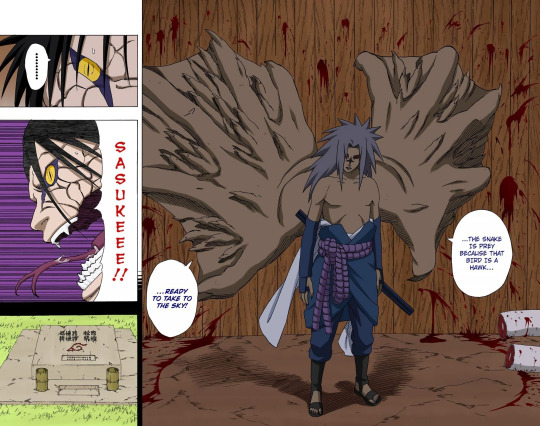
Sasuke (Literal): “A snake squirming on the ground dreaming about flying up into the sky. An impossible dream for you. Regardless of that you went after the chick in the nest, but now you find yourself as the prey. I'm going to soar into the sky...like the eyes of a hawk ”
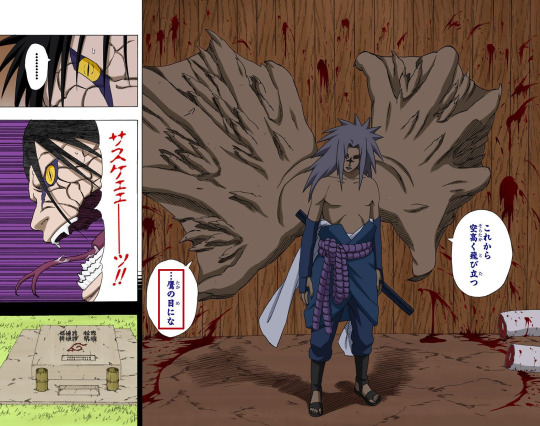
The word usage Sasuke used in here is the Japanese idiom: 鷹の目 ("taka no me"), literally meaning "eyes of a hawk".
This is from Japanese idiom ``Uno-me, Taka-no-me''. This is used as a figure of speech to indicate that ``cormorant'' and ``hawk'' are both ``birds'' that are associated with hunting prey, and ``with a sharp gaze as if aiming for prey.'' This idiomatic expression means : eyes of a predator, keen eyes, eyes of a cormorant, eyes of a hawk.
Birds have extremely good eyesight, and the eyesight of cormorants and hawks, which are able to detect and capture small, fast-moving prey, is many times better than that of humans. when they search for prey, their eyes are full of what is now known as ``powerful eyes/piercing eyes,'' and if the target were to look into those eyes, they would have a chilling effect. They will feel scared.
This proverb is also used to refer to the look in someone's eyes when trying to find faults or weaknesses in someone else. When animals hunt, they generally target the easiest to catch when there is more than one prey. The easiest prey is usually the one that is slow or lagging behind the pack, or the one that has some other disadvantage or weakness. A good hunter, such as a cormorant or hawk, does not miss its prey, but captures it without fail. This is why "the eye of the cormorant and the eye of the hawk" has come to refer to the way they look for rough edges by observing their prey.
Just like how Sasuke waited and observed for his prey's (Orochimaru) weakness and attacked him. Even Oro was surprised "I've never seen such a transformation before", it mean that Sasuke was training for that "transformation (chidori variants)" by himself without telling Orochimaru.
Sasuke was once a baby hawk...who was targeted by a snake. The snake trained him...as he was looking forward to that day when he finally achieve what he wants. But it turned out to be an impossible dream for him…. because now the baby hawk transformed into a matured hawk who targets the snake instead. Hawk soaring high above the sky, using their exceptional vision to spot its potential prey and descending rapidly toward its prey. Here, Snake (Orochimaru) goes from predator to prey when the hawk (Sasuke) flips the script. He's a matured hawk now, one who's capable of defending itself from the "snake".
201 notes
·
View notes
Text


The falcyons, once the dominant aerial predators of HP-02017 in the Therocene and Glaciocene, which preyed upon both grounded prey and other flyers, have seen a significant level of decline since the coming of the pterodents, some of which filled large, soaring scavenger, seagoer and migratory forager niches and thus gradually pushed the falcyons aside. Yet the falcyons, despite the competition, are doing quite well even in the Middle Temperocene, thanks to a fairly recent adaptive radiation at the Temperocene's dawn that allowed them to claim new niches and make a living in a changed world.
Some, such as the eastern Gestaltian triathler (Triathlopteryx gestaltis) have become generalists, taking advantage of any food source they can find. Triathlers, in particular, gained particular success thanks to being good runners, flyers, and swimmers all at the same time, allowing them to seek food in the sea, on the shore, or in the air, snatching up any small prey they can grab in their jaws in a wide variety of environments that reduces the pressure of competition. Hunting insects and wingles in the air, shrish and pescopods in the water, and small crustaceans and mollusks on the shore, triathlers such have many options and no shortage of available food should seasonal availabilities of one prey item come and go. Nesting in cliffside rookeries by the hundreds, even thousands, triathlers boast precocial young that can hunt on land within a few weeks, even while still under their parents' care, but still have to learn, through imitation and experience, the skills required for the air and sea.
Not all the falcyons, however, are as versatile, but are much more specialized in one specific medium. The swift airstrike (Velocipteramys aerovenatrix) is notable for its aerial prowess, able to dive-bomb its prey at incredible force and speed. Easily one of the fastest flyers, the airstrike specializes on hunting smaller flying ratbats, knocking them from the sky with such power that they are instantly stunned or killed upon impact, which the airstrike then snatches up midair. They live and hunt in mated pairs, with the female the larger of the two, as the smaller male can take on smaller but more-agile aerial prey and thus reduce competition with his mate during the breeding season, when she needs far more calories than he does.
On the other hand, the ground pterrier (Terranyctocyon ambulus) is, conversely, a far more terrestrial species. While a perfectly capable flier, it instead greatly prefers to hunt on the ground, or in trees, chasing down squizzels, furbils, duskmice and small rattiles in grounded pursuit, before pouncing upon them to pin them with its wing-claws and dispatch them with a bite. Ground pterriers rarely take wing unless threatened or provoked, or when traveling longer distances to find new hunting grounds, mostly preferring to roam on foot while foraging.
While fierce acrobats in the air, falcyons, like many ratbats, are more vulnerable on the ground, and thus the reason even the more ground-dwelling ones are still capable at flight. They are at their most exposed during the time when they are nesting: as pterriers and their relatives build their nests on the ground in hidden dens concealed by overlying plants, where their young, not flighted until they are several months old, remain. One of the pterrier's relatives, the wounded bloodwing (Erythropteryx pseudosanguis), has developed a peculiar strategy to protect its young: females possess bright red marks on the dorsal surface of their wings, hidden when folded and walking. If a predator is in the vicinity of the nest, however, the mother bloodwing will make a display where she pretends to be injured, flashing the red mark on her wing and making distressed sounded cries and limping motions to create the illusion of an easy prey. This is all a ruse, however, to lead the threat far away from the nest, and once she reaches a save distance she drops the act and flies off, leaving the confused enemy in the dust.
Among the largest and fiercest of the Temperocene falcyons, however, is the skewering harpshrike (Phobocynonyctus crucifigere), with a wingspan of up to five-and-a-half feet. Native to arid desert or semidesert regions of South Ecatoria, this unique species is remarkable for being a larger-scale predator able to tackle small hamtelopes, podotheres and zingos on occasion, which it then stores away in a grisly fashion: a larder of thorny trees, with the impaled half-eaten, dried carcasses of small animals hanging from their branches. But perhaps its most unusual feature is its rather canine-like head bearing facial markings that, by coincidental convergence, came to eerily resemble those of the sapient calliducyons: earning the harpshrike a place in their folklore as "person-headed flying monsters" notorious for occasionally snatching up unwary pups who stray too far from their parents.
----------
#speculative evolution#speculative biology#speculative zoology#spec evo#hamster's paradise#species profile
59 notes
·
View notes
Text
Good News - July 1-7
Like these weekly compilations? Tip me at $Kaybarr1735! And if you tip me and give me a way to contact you, at the end of the month I'll send you a link to all of the articles I found but didn't use each week!
1. Footage reveals 'miracle eagle chick' in flight

“In an unprecedented display of extended eagle parenting, the two white-tailed parents skipped this year's breeding season to continue to tend to their year-old offspring. The youngster's wing was broken when the nest fell to the ground during unseasonably wild weather last year. […] The fully-grown chick was being fed fish by its parents, caring behaviour that the eagle expert described as “unprecedented” for the birds. […] “If an immature bird was to reappear near its nesting parents or any other pair the following year [after dispersing], it would likely be aggressively chased away. That’s why this is so exceptional.””
2. Rare wild horses back on Kazakhstan’s Golden Steppe after being saved from extinction

“For the first time in at least 200 years, wild Przewalski's horses have returned to Kazakhstan’s Golden Steppe. [...] Przewalski's horses are considered the last truly wild horse left on the planet as other species like the American Mustang are descended from domesticated animals. The species were once common across the vast steppes of Central Asia. [...] The zoo will also be sending some Przewalski’s to Mongolia in 2026 where a reintroduction programme has seen their population boom to well over 850 animals.”
3. For one Austin summer camp, public transit is part of the adventure
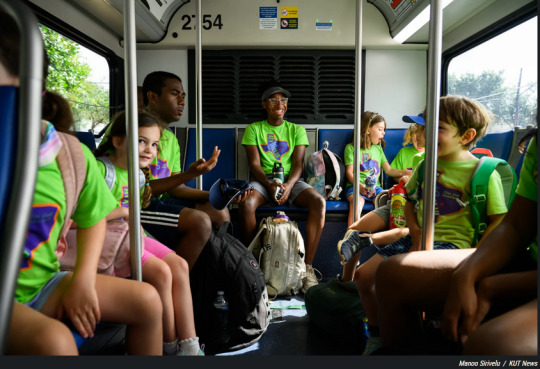
“[... “O]ver 90% of the kids will tell you that their favorite part of ATX Kids Club is riding the bus.” That’s the program’s goal: getting kids to have fun on public transit so they’ll grow up using it. The nonprofit’s summer camp, which takes kids ages 4 to 12 on field trip “adventures” around the city, uses Capital Metro buses as its main form of transportation. [...] Before camp, [the field trip leader] said, he believed in stereotypes about transit being dirty and “scary” — but his experience with Austin’s bus system has been the opposite so far.”
4. Brazil Prevents Meta from Using People to Power Its AI
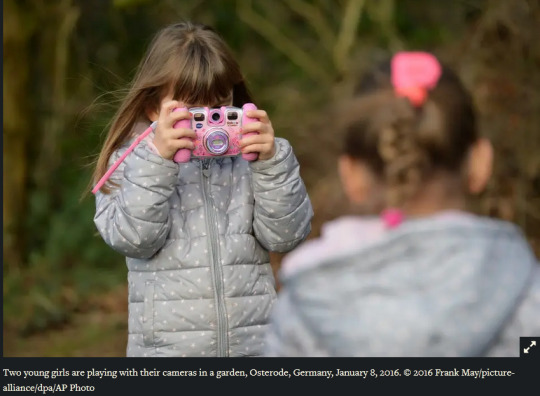
“[…P]ersonal photos of Brazilian children are used to build powerful AI tools without their knowledge or consent. In turn, others use these tools to create malicious deepfakes, putting even more children at risk of harm. […] The Brazilian government’s decision is a powerful, proactive move to protect people’s data privacy in the face of swiftly evolving uses and misuses of AI. Yesterday’s action especially helps to protect children from worrying that their personal data, shared with friends and family on Meta’s platforms, might be used to harm them in ways that are impossible to anticipate or guard against.”
5. Ambitious Living Shoreline Project Combats Coastal Land Loss in South Carolina

“Living shorelines stabilize coastlines by reducing the impacts of waves and rising sea levels. They are made of materials that promote the growth of marsh grasses and commercially important species like oysters and crabs. […C]oastal sites could offset almost 80 percent of tidal habitat loss with careful conservation and management. […] Young people in this AmeriCorps program receive training, a living stipend, an education award, and connections to potential employers.”
6. Pahranagat National Wildlife Refuge announces proposal to modernize water infrastructure

“Under the refuge’s proposal, the Service would improve 4,400 feet of an earthen water delivery ditch, rehabilitate 1,200 feet of Upper Lake Dam, develop 100 feet of new diversion channel into critical nesting habit for federally endangered southwestern willow flycatcher, modernize current water monitoring stations and improve 640 feet of the Pahranagat Ditch Drain. […] The improvements will result in significant habitat improvements for multiple bird species, [… and] also enhance flood control holding capabilities of the Upper Lake for the Pahranagat Valley.”
7. New chemical process separates textile fibers for easier recycling

“A combined team of chemical and biomolecular engineers [... have] developed a way to chemically separate fibers in textiles, allowing them to be recycled more quickly and cheaply than conventional methods. [... T]hey found they could break apart the textiles in as little as 15 minutes. They also noted that the process [breaks down polyester and spandex into] organic compound[s] that could conceivably be used to create more polyester. [... T]he material integrity of both the nylon and the cotton were retained, suggesting they could be used to make new batches of clothes.”
8. Pongamia trees grow where citrus once flourished, offering renewable energy and plant-based protein
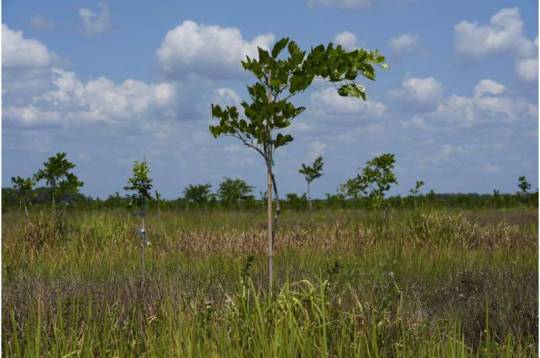
“[Some Floridian] farmers are turning to the pongamia tree, a climate-resilient tree with the potential to produce plant-based proteins and a sustainable biofuel. […] Pongamia trees also don't need fertilizer or pesticides. They flourish in drought or rainy conditions. And they don't require teams of workers to pick the beans. […] The legume is now being used to produce several products, including Panova table oil, Kona protein bars and protein flour. The legumes also produce oil that can be used as a biofuel, largely for aviation, which leaves a very low carbon footprint[….]”
9. Trans candidate celebrates receiving more votes than anti-trans campaigner Posie Parker

“An independent trans candidate says that she hopes receiving more total votes than anti-trans campaigner Posie Parker at the general election will show trans children that they are loved. […] Bristol Central was won by Green Party’s out bisexual co-leader Carla Denyer, while Parker received just 196 votes, equal to 0.5 per cent[….] Elsewhere, trans candidate Sophie Molly secured 225 votes standing as an independent at the other end of the country, in Aberdeen South[….]”
10. Ohio zoo celebrates birth of critically endangered western lowland gorilla

“The Columbus Zoo said the gorilla was born June 29 and first-time mother Sue is "very attentive and providing excellent care to her little one, who she nuzzles and cradles closely." […] “With tiny hands and beautiful big brown eyes that melt our hearts, this baby is absolutely precious—in regard to both the cuteness factor and what the baby represents for this species’ future. We are proud of the dedication of our care teams who diligently work to provide the gorillas with top quality care and wellbeing while continuing the legacy of the Columbus Zoo’s renowned gorilla program,” said Audra Meinelt, curator of the Columbus Zoo’s Congo Expedition region.”
June 22-28 news here | (all credit for images and written material can be found at the source linked; I don’t claim credit for anything but curating.)
#good news#hopepunk#eagles#horse#endangered species#birds#public transit#children#ai#brazil#privacy#habitat#ocean#wildlife#recycling#science#farming#renewableenergy#trees#trans#transgender#uk politics#politics#civic engagement#lgbtq#zoo#gorilla#primates#baby animals
17 notes
·
View notes
Text
Phantoms

The phantom is a large, player sized aerial predator known for their nocturnal nature and terrible aggression towards those they find. While often seemingly appearing out of nowhere after numerous nights without sleep, causing the rumor that they may be caused by sleep deprivation, they actually track down players they have noted repeatedly within an area.
Their gill-like filaments are actually chemosensory antennas while the smaller almost horn-like antenna are used for communication between different indivuals of the species. The gill-like antennas can sense the lingering scent of someone roaming at night and thus attracts the phantoms more so than players that roam solely during the day.
Furthermore, they are notable in the fact that they are one of several other organisms capable of true, powered flight besides bats, birds, and insects like bees.
Other organisms such as the ghast have their own mechanism where they inflate air sacs that allow regulating of height whereas their sail-like limbs allow them to regulate motion. This however is not true powered flight as the ghast can not influence its ‘flight’ furthermore and can be thrown off kilter as a result of thermal heat spouts or sudden shifts in nether air currents.
The phantom uses its two powerful hind legs to launch themselves into the air/push themselves off roosting places, attack prey, or for clinging to areas for when they roost during the day. These limbs are often not noted for they are normally held laid flat against the body along the tail. This allows for increased aerodynamics. The claws along the wings are used solely for roosting and/or grooming.
Phantoms are also noted for their hatred of sunlight, their sensitive skin easily affected by direct sunlight. So while they are very aggressive and quick to attack, they are very vulnerable to cutting blades/their wing membranes being damaged. Though despite this, they can heal quite well and have incredible regenerative abilites.
This has caused the membrane of the phantom to be desired for their ability to heal damage to things such as elytra wings. Their membranes are also quite useful for the brewing of slow fall potions.
This has caused some overhunting in the past though they are also known to come into conflict with players simply due to their aggressive behavior.
Another interesting thing about the phantom is their curious origins. For while they may have a look almost like that of a manta ray, they are infact not fish. They are actually more so related to the axolotl.
The axolotl afterall is known for their ferocity when it comes to hunting, are notable for their regenerative capabilities, and their natural habit of lingering in darker areas. It is uncertain when the two diverged, or where they may have diverged, but either way, it’s believed the phantom grew larger during this aquatic timeline and either through competition that lead to it being pushed out of its aquatic niche or following moving prey out of the water, it left and took to the air.
Eventually fin-like limbs allowed for gliding and further development led to flight. Their gills have taken to filtering air and taking in air from water vapor present, their jaws grew more powerful, and their limbs developed stronger than the mostly simple legs of the axolotl.
They as well do not require living in water to survive, as they are able to retain the water they take in through food and the air around them; they are not quite amphibians, neither are they truly reptiles, in a grouping of their own.
They as well are able to give live birth, whereas the young clings to the underside of the parent until grown enough where they can start practicing flight until they are powerful enough to start flying.
Overall they are a very peculiar and interesting creature.
#minecraft mobs#minecraft speculative biology#minecraft phantom#speculative biology#my art#traditional art#my design#minecraft biology
59 notes
·
View notes
Text
Okay so Freeza's final form power level being like Three Million at base and One Hundred And Twenty Million at 100% is total bullshit and completely throws off the reasonable perception of the power scaling of the series, but IGNORING THAT SHIT and looking at the rest of the Freeza force on its own, I think it should be recognized that Vegeta was easily the 9th or 10th strongest person in the entire intergalactic Freeza Army. Which ain't nothing to sneeze at.
The average Freeza Soldier was probably in the ballpark of around 1,000, although most of them seemed to be incapable of proper ki control and needed blaster weapons since they weren't able to fire energy blasts of their own. Most of them seem capable of flight though, but fucking so was Dende. For reference Appule had a power level of 1,600.
Raditz had a power level of about 1,200 - 1,600 depending on your source. Makes him average in the scope of the rest of the army, but remember Saiyans have the Oozaru Great Ape form, which is a power level 10x multiplier. So on the night of a full moon Raditz can shoot up to 12,000 which would put him head and shoulders above 99% of the rest of the army. Sure Saibamen also had a comparable power level, but they were genetic experiments who were created in a lab whereas Raditz was all natural. The fact you can create a weapon that can cause as much damage as a single soldier with his bare hands doesn't speak ill of the soldier at all in my opinion.
Nappa had a power level of 4,000 which is a significant enough jump to explain why Raditz would be considered such a lowly shit class warrior compared to the Elite that Nappa and Vegeta represented. And again the Oozaru boost makes for a significant benefit in terms of their status. Oozaru Nappa could have squashed transformed Zarbon.
Vegeta when he was on Earth had a power level of 18,000 which definitely explains why Nappa and most of the rest of the Freeza Army is piss terrified of him. We've jumped to five digits worth of power at this point. And Vegeta isn't just strong he's also smart, he's the one who pointed out to Nappa that just relying on numbers was foolish and that power level alone did not define the Earthlings as a threat. Goku had a reading of 5,000 while he was racing to the scene and he ordered Nappa to kill the rest of the earthlings before he arrived because he knew that Goku would give them a run for their money if he displayed the same capacity for increasing his power level from what the scouter said. So Vegeta is strong AND understands the realities of battle cannot be predicted by a single power number reading.
On the other hand we very shortly thereafter meet Cui, who is stated to be around the same power level as Vegeta at 18,000. We don't know enough about Cui to know if this is typical for his species or if he was a freak of nature on his planet. But we finally meet someone who isn't scared of Vegeta because they're actually on a comparable level, at least before the near death power boost starts factoring in.
Then there's Dodoria who has a power level of 22,000 and Zarbon who has a power level of 24,000. Two individuals aside from Freeza who are EASILY stronger than Vegeta. That's a big deal, but like. It's two people. Out of an army of what could presumably be thousands to millions. Vegeta is still standing pretty good in that hierarchy, tied for 4th place.
Then we meet the Ginyu force and aside from Guldo, the other three members are around 40,000. And Vegeta reacts appropriately to finding out they're arriving on Namek, FOUR dudes who are more than twice as strong as him and Guldo who has weird freaky powers. He probably grumbled under Dodoria and Zarbon, but he was shitting his pants over the Ginyu Force and it seems reasonable why. And Captain Ginyu has a power level of 120,000 (which, like, come the fuck on that's stupid he's more than twice as powerful as everyone else in his squad like fuck off that's officially when the scaling got ridiculous) so for as high an opinion as Vegeta had of himself he was keenly aware of how outclassed AND outnumbered he was by the Ginyu's.
So in terms of ranking, Freeza was at the top, then the four Ginyu members, then Dodoria and Zarbon, THEN Vegeta and Cui. So literally Vegeta is the 8th or 9th strongest member of the entire army, which again presumably could have thousands to millions of soldiers in it. Top 10 out of an ENTIRE ARMY is pretty fucking good. Vegeta definitely would have been recognized and feared by the vast majority of the Freeza Force.
8 notes
·
View notes
Note
Question- do companions get their wings clipped, or pinioned? Not to out myself as a bird nerd but while they're both very bad things to do to a bird, one is a LOT worse than the other.
Clipping a bird's wing means cutting back the primary flight feathers on one wing. Clipping only one wing prevents the bird from properly balancing in flight, meaning it'll swerve to one side and fall to the ground if it tries, so it won't be able to maintain flight. It's technically painless (though robbing a bird of its ability to fly is still Bad, they're designed almost entirely for wing-powered flight from the ground up. You should see what the avian respiratory system looks like), and is reversible.
After molting, the flight feathers will grow back, and the bird will be capable of flight unless its wings are re-clipped. However, clipping often starts before a bird can learn to fly, and even without that the wing muscles will atrophy over time due to disuse, meaning that a bird whose been getting wing-clipped every molt will still have a significant road to recovery after the clipping stops, and may need to be trained or re-trained on the basics of flight.
Pinioning is worse. Pinioning means amputating one wing just above the wrist joint (the second joint of the wing, further from the body. usually just past this, to leave the thumb/alula/"bastard wing" intact so its feathers cover the stump), usually while the bird is still so young that its bones haven't had time to harden, usually without painkillers of any sort. This has a similar effect to clipping, but A. it's fully permanent and B. it throws off the bird's balance even when on the ground, as that's a not-insignificant amount of weight removed from just one side (if both sides are clipped/pinioned, the lack of imbalance means the bird can re-learn how to fly even with shortened wings). Doesn't effect heavier birds like waterfowl too bad iirc, but those tend to keep both feet on solid ground (or just float on water).
A pinioned felfolk would likely have some trouble with delicate balancing, especially as instinct might tell them to use their wings to aid them in balancing- which only makes things worse, since one is, of course, pinioned. One with clipped wings might struggle a bit, but the weight difference would be a lot less drastic, and it's just a matter of waiting to molt & regrow those flight feathers (molts usually happen at least once a year for most species, sometimes more often but most will at least molt in late fall, so their feathers are in good condition to keep them warm during winter)
...Sorry for the unprompted nitpicky inbox essay, but both options have significantly different implications for dear Castel and I'm not good at keeping my mouth shut about bird stuff. Still, I hope this could be helpful to you in some way!
Okay first off: please don’t apologize!! Thank you sincerely for bringing this to my attention… I always love learning new things about animals, even if they’re heartbreaking like this.
Everybody say thank you to bird nerd anon!!
After reading through this a few times and really think about it, I’m gonna alter a few things now that I’m more informed:
(I’d also like to reiterate that what the Sunguard Guild does to their companions is barbaric and not the norm for Guilds and their companions. I do not support the practice of declawing, pinioning, or wing-clipping.)
The Sunguard Guild typically pinions their companions. They have this process done to prevent their companions from leaving the Guild, and typically the head of the primary companion family, or the overall oldest companion, is in charge of ensuring that the pinioning goes well and relatively smoothly.
So most of the current Sunguard companions have a pinioned wing.
#(also if you want to keep spamming my inbox about bird stuff-#I might not reply publicly but I shall file the info away v loyally for later 👀)#ailurocide#ask#anonymouse#spotty speaks#ailurocide: the companions#ailurocide: the sunguard guild#keyword: m o s t companions
13 notes
·
View notes
Text
Aegis

(Finally going to start posting my superhero OCs! Welcome to the Flamesea Project.)
Real Name: Ka’list Gale-li (Jovian), Calista Galindo (Human)
Age: 35
Species/Race: Human/Jovian Hybrid, Latin American
Gender: Female
Sexuality: Lesbian
History:
Cali was born as a human, but her early childhood would be completely turned around when her family was killed during an alien skirmish on earth. In the process of the attack, Cali would be enveloped by a burst of warp drive energy (known as flamesea energy in-universe) from a destroyed ship- resulting in her gaining extremely unstable and sporadic powers. The Jovian survivors of the battle, out of sorrow for the situation, elected to raise Cali. During her new upbringing, Cali had her DNA spliced with the aliens that adopted her in order to calm her instability- said DNA splicing would give her the powers she has today. Once she came of age, she would return to earth and protect it, ultimately becoming one of its greatest heroes.
Personality:
Cali is a showboat during combat, often goading her enemies or boasting during the fight, or using her weather powers to "set the stage" for herself. This partially comes from her major paragon complex, but also from a desire to divert as much of the fight away from other people as much as people- even other heroes she works with.
While off the job, Aegis tends to not stay in one place for long- usually looking for new places to eat or simply relax and take in the world around her. In spite of her showmanship, she doesn’t tend to interact with regular people that often, which makes it harder to develop relationships outside of her already existing friend group.
Powers:
Enhanced physical prowess- Cali is far stronger than the average human, being strong enough to lift many times her own weight, and being tough enough to sustain and resist far more damage than the average human.
Weather Manipulation- By far one of Cali’s most impressive abilities, The hero has a near complete control over weather phenomena. Not only can she call storms and localized changes to the weather during combat, but she can also manipulate and bend certain aspects of this weather to her will, such as-
Vacuum punches- Aegis can create pockets of vacuums to enhance the power of her punches, similar to a mantis shrimp. This means that her punches can be made far more explosive and striking.
Flight through wind manipulation- Cali is capable of manipulating the wind in order to fly- in conjunction with her cape and stormeye. She also uses the wind for dramatic effect and presentation, causing her cape to billow when she desires it.
Lightning casting- Aegis can call lightning into a specific area to strike a target. She can also strike herself with lightning, if for some reason she needs the extra volts for any reason- whether it be to “power up” by conducting electricity through herself, or to shake off an enemy who might be grappling or attacking her.
Equipment:
Stormeye- This device was created by Cali’s surrogate parents to allow her to fly in the same way they do- emulating their biology to harness the wind which Cali manipulates. The device alone doesn’t fully allow this, however, and thus Cali also relies on her costume’s cape to help the process- an addition that was her suggestion based on the heroes from earth she remembered. In order to allow for this, of course, the cape has to be rather long, somewhat emulating the fins of the alien species.
6 notes
·
View notes
Text
Volant Vertebrates of Foliest
Part One - Therodactyls
Fairies share the skies of Foliest with a range of other aerial organisms. Insects and spiders have both evolved powered flight, while certain rainforest worms have developed the ability to glide between trees. Among vertebrates, flight has evolved thrice. The earliest to take to the skies were the jimmylegs, descended from ancestors much like Sharovipteryx, which adapted their hindlimbs into wings. The next were the birdonts, basal archosaurs that glided on outstretched ribs, which were then modified until capable of powered flight. Finally, the mammals produced their volant representatives, the therodactyls.
Evolving in Foliest's late Jurassic from gliding, eutriconodont ancestors much like Volaticotherium, they got their start as insect hunters with some larger, coastal forms specialized in fish. Floral turnover in the Cretaceous resulted in the expansion of closed-canopy forests, and this environment seems to have favoured the therodactyls over the birdonts, in many ways their ecological rivals. They underwent rapid bursts of evolutionary radiation in this period and slotted into diverse niches they had never held before. By the middle Cretaceous, the two clades had reached an equilibrium. Therodactyls tend to be the largest flying vertebrates in their ecosystems and dominate coastal, wetland and forest canopy habitats, with birdonts more numerous in plains, scrublands and the remaining open forests. Jimmylegs, meanwhile, avoid competion simply by staying small and mostly nocturnal.

Pictured here are some representative species. At the top is a macrocarnivore that primarily hunts other therodactyls on the wing. Middle is a plunge-diving piscivore that soars above the waves and pursues fish for short distances underwater. Bottom left is a nut and seed eater that has convergently evolved traits similar to rodents, such as cheek pouches and continuously growing incisors. Bottom right is a frugivore that encourages algae and bryophytes to colonize its fur, providing camouflage against predators that ambush from above (easier than on Earth thanks to the rate at which fairy-tended plants grow).

One of their more unusual traits is the fact that they utilise all four limbs for flight, similar to certain dinosaurs such as Microraptor. With a wing membrane stretched between digits, as with bats, they can alter the shape and size of the wing by flexing certain fingers and toes. This sequence demonstrates a predatory therodactyl in three modes of flight. The first is the typical wing position, with a single, large surface on each side allowing efficient soaring. The second shows the longest digit on each limb being folded, bunching up the membrane and separating each wing into two, improving maneuverability at the cost of greater energy expenditure. The third portrays all digits on the feet being tucked close to the body, reducing the animal to a single, smaller set of forewings. When hunting, a therodactyl would begin in the first position while locating prey, switch to the second if the initial strike failed and a chase was required, and the third when the hindwings were needed not for flight, but to strike with the talons.
#speculative evolution#speculative biology#speculative zoology#spec evo#spec bio#spec zoo#prehistoric mammals#eutriconodonts#volaticotherium#therodactyls#worldbuilding#art#creature art#creature design#fauna of foliest#fairies
2 notes
·
View notes
Text
@kirbyoctournament here is Marx but not Marx. Multiverse woop! A creature.
Name: Marx (should we call him something different to differentiate him from other Marxes? Normal ish animal shaped Marx?)
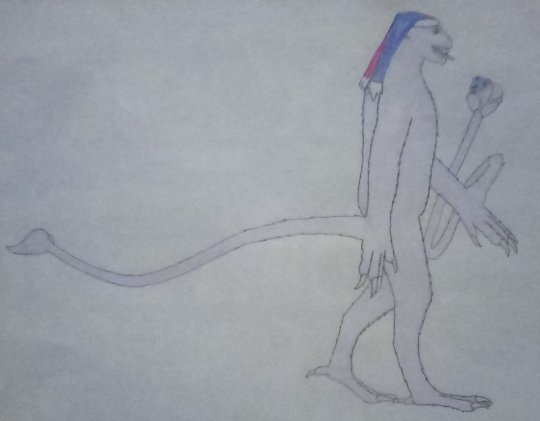

Personality: A goofy feral child. His main goals are food and entertainment. Luckily his standards are low, so he's fine with scavenging from the garbage, though he loves junk food. He travels around and has all sorts of adventures. Often up to mischief. His regenerative immortality gives him confidence and the ability to be reckless. Depending on how he's feeling, he sees himself as an outcast and monster and hides his predatory nature, or he openly uses his powers to mess with people and say things like "you dare oppose me mortal?" (at the slightest inconvenience because it's funny). Generally doesn't kill and eat sentient species(in his right mind), but he might play hunt with unsuspecting people in the woods. He's usually nice, but if he doesn't like you he can be a snarky jerk. If he REALLY doesn't like you you might be on his menu. Only wears his bow tie when he needs to be fancy. No shoes, because he likes to have his claws handy.
Backstory and Lore: He used to be the same species as Kirby(looks like a biped tailless salamander here) but was experimented on by NME. They accidentally put a piece of a being from the dimension where magic originates in his soul. This allows him to produce his own magic and gives him immortality, but the crazed fragment in his soul has some influence on him, giving him a constant hunger and an urge to increase his power to attempt to make it whole again. They lose control of him and he escapes and messes up his home world pretty badly until powerful warriors fight him off; sending his dormant seemingly lifeless form into deep space. Many years later he crash lands onto Magolor's home world with no memory of his past. They become friends. They go through a wormhole into Another Dimension and end up on Halcandra. The wormhole destabilizes, leaving them stranded there. They find an old ship; it's ai consciousness teaches them Halcandran and now they live on the ship having adventures. Marx's hat, like The Lor, contains a pocket dimension with an ai consciousness, though this one is a bit deranged. Calls his hat Hatrick (or an equivalent hat naming pun in the Halcandran language). He found his hat on Halcandra, and is very attached to it. Marx has some shape shifting capabilities, allowing him to adapt to environments and situations. Often its just used to make and reabsorb his wings. When not used for flight, the wing sparklies are turned off and the wings can be used as prehensile tentacles. His bird like respiratory system kept from his kirb days allow him greater strength and endurance. Marx sees Magolor as an older brother figure and have a strong bond. Though they are often apart, Marx going on adventures trying to find meaning to his existence and Magolor continuing to search for his home world. Marx is around 2 and a half feet tall.
There are further details on a few of my posts if you want. Here's his page:
17 notes
·
View notes
Note
May I know some of your foul legacy headcannons? Cool art btw I always love seeing a more body horror spin on the idea
Wow oops I have no idea when I got this ask I’m sorry ;; finishing chapter one kind of Ate my brain
Thank u much I do love monstery foul legacy a lot a lot
Uhhhhhh headcanons. Idk what all I’ve posted about before and this is in no particular order or along any particular line of thought. Keep in mind I’ve constructed a LOT of world building behind the scenes lmao
* Nesting. Started out feeling weird about doing it, one of the first things he felt unable to control himself doing. came to accept it and embrace it, friends would gift pillows and blankets to add
*tongue(s) are deceptively long and coil in a pouch just underneath his chin when not fully extended. Rubbing the pouch feels good and nice and he’ll stick his tongue out slowly until it’s like, totally hanging outside the side of his face and he sneezes a bunch
* scared by loud noises. Partially innate fight or flight instinct, partially trauma from being struck by lightning when he was lost in the liyue woods not long after permanently transforming
* Caterwauls outside to declare territory. One of those instinctual things he just Does now and realizes after the fact that he did it
* Flicking and wiggling wings to ward others away/express excitement. Wings aren’t super capable of flight, more of a communication thing, but can glide
* Hiding in blankets when he wants to be alone
* Always has to be bundled up when it’s even slightly cold. This is mostly due to damage done to nerves from abusing transformative powers prior to turning
* Loafing when wants to conserve body heat or defensive
* Cravings for raw meat, flowers, sunsettias. Abyssal beast species is technically a pollinator of megaflora as well as an omnivorous hunter-gatherer species
* Intolerance for dairy, complex carbs (not allergic, just prone to indigestion)
* Fresh snow drives him nuts, it feels weird and awesome on his face so the first time he felt well enough to go outside in the winter he shoved his face in the snow and ran around rolling and giggling
*his face plating and bone spurs are covered by thick vascularized flesh and he can definitely feel things touching those parts, it just feels Different. Feels leathery but soft to the touch. He loves having his cheek plating stroked.
*face plating and darker patches of skin get flushed very easily when flustered, overexerted, or in heat
*he’s actually pretty small for an adult of the abyss species he’s turned into, due to abuse of transformative powers prior to turning, and his body struggling to simultaneously process two incongruous species’ puberty periods growing up. As a result his joints are a little weak now and his heat cycles SUCK. like REALLY BAD.
*even though turning and losing abyssal magic powers to numb his body to all of This kind of fucked him up really bad and he’s nowhere near as capable as he was when he was a Harbinger, he’s stubborn as hell and will overwork himself trying to regain proficiency in weapons with this newly permanent form
31 notes
·
View notes
Text


Name : Krow [Belongs to @thekrows-nest ]
Dragon Species : Bird Wyvern
Gender : Enby
Dragon Power : Venomous fangs [+ immunity towards his own Venom]
Description :
Krow is a two legged, brown scaled Wyvern with a feathered chest and a semi-feathered head resembling that of a bird, more specifically those in the corvid family.
On his head are a crown of very thin, dark brown feathers that could be mistaken for hair. On the side of his face he has feathers that act as whiskers, helping him detect changing air movement.
The wings have a slightly lighter brown coloration with the inside of the wing being purple-ish in colour. The leathery insides of the wings has been seen to change colours ranging from blues & purples to pink, red and on rare occasions a bright, almost glowing green.
On his behind, is a long, hand-tail with four clawed digits that could easily touch the tip of his beak. Along the tail are purple plates that seem to protect the tail from harm, they also have been noted to change colours.
His legs and feet resemble those of predatory birds, his feet have three digits each with talons at the end. The hallux seems to be non-existing on both sides, instead leaving a very small talon behind on the upper part of the leg.
Other Information :
- Krow's hunting style is based more on hiding in certain areas and waiting for prey to come by. His brown scales and colour changing wings/tail scales help him blend in with his surrounding.
If no prey could be found it's speculated that they would take flight around their territory to search for other food sources such as; Vegetables, fruits, nuts, eggs or large insects.
- His tail-hand is often used by him for creative purposes, such as drawing, painting & sculpting.
- While like many others in the facility, Krow is capable of human speech. They do suffer from a speech impediment causing them to stutter a lot.
- Similar to other Bird Wyvern's who have a pack of their own, Krow has a murder of crows following them around. It isn't known if they are a flock or simply follow him because they worked together on previous hunts.
- While being one of the smallest dragons in the facility, Krow's venom is highly dangerous and should be extracted with caution.
[For better quality, click on the pictures]
20 notes
·
View notes
Text
Mr.X/ ManHunter X
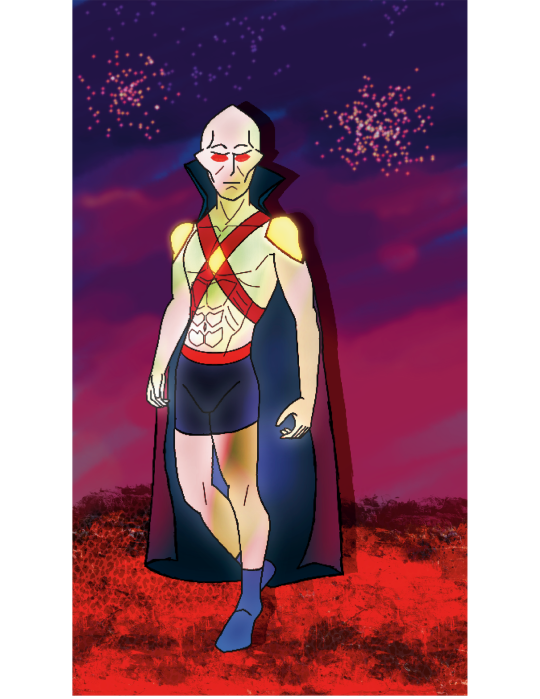
On the planet Mars lays a species of powerful Martian’s. However, between the long departed rights between the supreme Green race over the White lower 2nd class system and civil war lead to the planets greatest lost at the hands of Darkseid.
Only one Martian escaped X. A criminal of both Green & White decent X had dealt with the difficulties of being welcomed to either side from the Martian race accused of a crime he didn't comment the alien made if way towards the Planet Earth. And came into contact with Mr.X a special agent working for the government upon, accident killed the human with a mix of guilt and fear of this unknown planet the Martian did the unthinkable.
Performing a forbidden mind technique the halfbreed alien absorbed all the dying humans memories and being into his own allowing it to steal the former agents life for itself. Now as Mr.X the Martian has made a life for itself while also upholding conscience and morality for meta-humans such as SuperWoman and greater threats believing Darkseid may come for Earth.
Powers & Abilities
Martian Physiology: The average Martian possesses the potential for the following power set.
Shape-Shifting: Martians have psionic control of their physical for down to the molecular level. This allows them to a form of shape-shifting that allows them to mimic other forms, elongate aspects of their body, increase or decrease their physical size, and so on.
Size Alteration: As an extension of their shape-shifting abilities, Martians can easily alter their size, shrinking or growing to gigantic size.
Invisibility: Martians can cause the biopolymers in their bodies to lose their ability to reflect light, making the Martians invisible to normal light and human sight.
Phasing: Martians can go through solid matter.
Superhuman Strength: Martians possess vast levels of superhuman strength and are among the few races that are able to match SuperWoman in terms of raw strength. Martians can easily shatter reinforced concrete and steel, lift and carry hundreds of tons with ease and deliver incredible damage with their blows.
Superhuman Stamina
Superhuman Durability
Superhuman Speed
Superhuman Agility
Superhuman Reflexes
Regeneration: Martians have powerful regenerative powers that enable them to regenerate their entire body from a severed limb, they can further enhance their regenerative powers by drawing mass from nearby sources.
Telepathy: Martians have the ability to read the minds of others and project their thoughts to varying degrees. They can also project their mental essences into a gestalt community known as the "Great Mind". Through this, the community can enhance the telepathic strength of other Martians. This power can also enable them to reverse the effects of amnesia or psychological brainwashing.
Longevity
Flight
Telekinesis:Martians have mind-over-matter abilities and can lift and move objects with their minds. They can also employ their telekinesis in an offensive way by discharging telekinetic blasts capable of great concussive power
Weaknesses
Vulnerability to Fire: Martians are much more vulnerable to fire than the average Earth human. At times this has been portrayed as physical, psychological, or a combination of the two. The effect of this is to strip any Martian of their powers as they involuntarily lose control of their body. X has stated that his reaction is relative to the flame, a birthday cake will make him tense but won't make him wilt.
Chocolate: While on Earth, X has found a great love for the human treat of chocolate due to his physiology making him addicted to the chemicals used in the Earth snack, Chocos. Withdrawal symptoms include violent bursts of rage and loss of intellect. However, this addiction is treatable due to Mr.X's love for Kombucha the fermented drink has a canceling effect on the chocolate though it will leave X with discomforts until his strength is regained
#newpost#superhero#the owl house au#the owl house#amphibia au#amphiba#Amphibia Mr X#dc martion man hunter#dc fanart#art#j'onn j'onzz#green Martian#white Martian#web comics#illustration#superwoman#the owl house amity#amity blight#web comic#dc comics#batman#dc universe#dcau#justice league#camila noceda#eda clawthorne#dceu#green man#white man
5 notes
·
View notes
Text
Canadian Wilderness Dragon
Scientific name:
Ursus Draconis (Bear dragon)
Class:
Verum Draconis (True Dragons)
True dragons are defined by three features:
Six limbs (Two wings, four legs), the power of flight, and the ability to breath fire (This changes between species)
Habitat:
The northern hemisphere, and the northern most part of North America (The upper parts of the United States, Canada). Though some have been recorded as far south as the Andes and the Patagonian coast, and Australia. Even to the southern tip of Africa.
Diet:
Large animals, such as Moose, Elk, Bears, Bison, wolves, Elephant seals, Walrus, caribou, Musk Ox, and Big horn sheep. One individual was recorded hunting Great White Sharks and Orcas, and scavenging off of breached whale corpses. They even eat plants, berries, and tree-roots. They also hunt Leopard Seals.
Description:
Large dragons with a strong-bear like appearance. Their top canines are curved like saber-toothed cats, but shorter and broader. They are heavily muscled with a thick, draft-horse like neck. They are Plantigrade, meaning they walk on all of their foot, much like bears. Their horns have a curved look to them, much like Big-horn sheep. They have a heavy-set jaw with a small, horn-like protrusion on it, and a very heavy brow. Under their hard, bullet-proof scales, is a thick layer of fat. This acts as an insulation during the harsh winters of their northern homes, and allows them to hunt in the arctic circle.
Their nose is arched, and is very sheep-like in its appearance. Their wings are smaller than most dragons, but still large enough to lift their bodies for flight. Their tail is heavily muscled with a scythe-like piece of bone on the end of it. Their coloration can vary, often mimicking the animals in their habitat.
Females are larger than the males and are more heavily muscled than their male counter-parts. Females have thicker horns and a larger crest than males, and broader noses. Even their jaws are broader than the males.
Mating habits:
Females come into season during the spring, and during this time, males show off in feats of strength and endurance, by shoving each-other, much like male elephant seals. But in the end, the female chooses her mate.
Females gather in large groups, in certain areas. The Yellowstone region is a popular place, and the state of Montana. Dragon researchers call these gatherings 'flockings', and it is during this time is when the most spectacular displays of dragon behavior is seen.
Females roar, their calls broadcasting off of the rocky faces of the Rocky Mountains. This is a signal for males to come and gather, to show off to receptive females. The most dominate female in an area has the best selection of males available to her.
Canadian Wildernesses have a mammalian reproductive system (Placenta mammals in appearance). They share this with Irish Mountain Dragons, American Golden Dragons and with the African Night Dragons, suggesting a common ancestor with all four species or a similar evolution path between all four.
Females are also capable of reproducing asexually. This only happens when there are no males available, but plenty of food and resources for the two-year long gestation period.
Gestation:
Pregnant females after mating gestate for two years, the same as an elephant, and during this time, they hunt for calorie rich food and calcium. They continue to do this up until the eight months of their pregnancy. They then focus this time into finding a suitable birthing territory. The preferred territory is one free of other dragons, especially males and other nesting females. A female can carry up to four hatchlings in her womb. (Each one is roughly the size of a fully grown draft-horse).
The hatching season:
The hatching season happens in the spring, two years after mating. During this time, pregnant females are highly aggressive and will attack anything on sight. The only exception is Bonded Dragons.
The birth is quick, 4-8 hours, and females give birth in remote locations. (Often high in the mountains). They lie down on their sides, as their hips, back legs, and tail lock up. The hatchlings are born-head first, with their wings plastered on their sides.
Notable dragons:
Everest: The oldest recorded Canadian Wilderness, being roughly one hundred and fifty when she was spotted and tagged by researchers off the Pacific Northwest.
She is a large female with a missing horn, one has a small notch in it. One of her wings has a small tear in it. There is also notable chemical burn scars on all four of her legs. She has a wolverine-esc patterning on her body. She is famously known for hunting Orcas and Great-white sharks.
Scar-face: An old male of a dragon, recognizable for his crooked jaw, broken saber-fang, and a mess of scars on the right-side of his face. He has a Grizzly bear patterning on his scarred body. Despite his injuries, he is still going strong. It is know that he and Everest had paired up in the past.
4 notes
·
View notes
Note
I like your super hero OCS! Can I hear more about the mutant bird he sounds really cool!
Elastabird
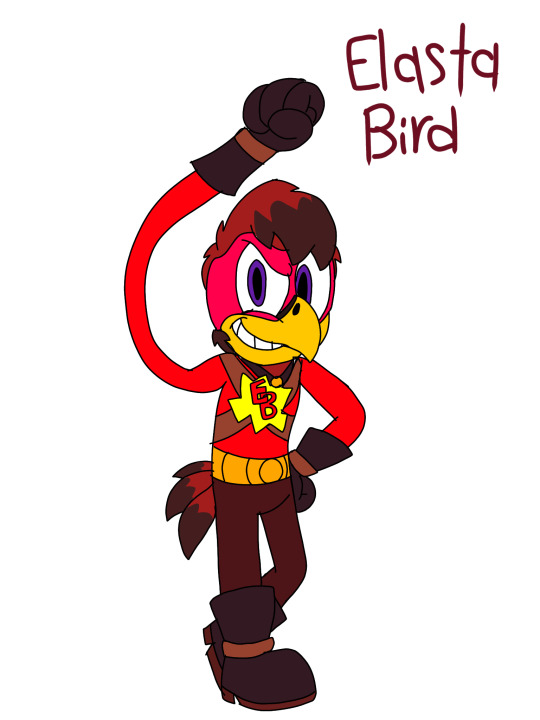
Name: Elastabird
Real name: Crimson
Age: 14
Gender: male
Sexuality: gay
Favorite color: red
Location: New York city
Place of birth: nuclear waste plant
Occupation: Superhero
Nationality: American
Species: mutant red cardinal
Character trait: good
Personality:
Sweet
Brave
Determined
Joking
Chill going
Caring
Energetic
Powers and abilities:
Flight
Elasticity
Super strength
Heat ray vision
Super speed
Invulnerability
Immortality
Accessories:
Utility belt
Physical characteristics:
Is a mutant bird
Is very allergic to mold
Can punch or kick someone from a mile away
Has to wear a special mask when going into abandoned buildings
Is great with chemicals and other substances
Is very short (about waist height)
Can bounce back bullets with his body
Likes:
Adventure
Crime fighting
Hanging out with friends
Science
Keeping people safe
Board games
Video games
Paranormal adventure shows
Reptiles
Reading (mostly comic books and murder mysteries)
Justice
Playing outside
History
Dislikes
Crime
Being stuck inside
Spicy food
Getting sick
Having to enter abandoned buildings
Having to clean anything with mold
Dragon Dude's sass
Faults:
Is self conscious about being called short
Can be impulsive sometimes
Fears:
Losing his friends
Lightning
Thunder
Friends:
Wonder Girl (Penelope Prince)
Voidz (Adrian Wayne)
Electrodog (Volts)
Dragon Dude (Crispian)
Alexa Roseville
Enemies
Dr. Vortex (Victor Wayne)
Black Knight (Vanessa Luthor)
Freezeo
Any villains
Relationship status: single
Family members:
Unknown father
Unknown mother
Unknown siblings
Backstory:
Crimson was hatched near a nuclear waste plant where toxic rubber substances and toxic chemical waste are usually dumped. Because of this, he was mutated into an anthropomorphic being with the capability of human speech and the power of elasticity from the rubber substances and other superpowers from the toxic chemicals. Since he was a half bird half human hybrid, he didn't know how to fit in amongst the other birds or humans, so he just stayed in hiding in the trees of New York town Square where he thought nobody would see him. One day, he saw Wonder Girl, Voidz, and Electrodog stop two criminals from robbing a bank near his tree, and he was so amazed by them and the fact that they had superpowers just like him that he wanted to join them, but at first he was afraid they would think he was a freak because of his appearance, but then he saw a third criminal pull out a gun on Wonder Girl when she wasn't looking and quickly took action to save her. Using his super speed, he rushed over to her, jumped in front of the bullet, and bounced it back at the criminal with his elasticity, causing it to hit them in the shoulder and drop the gun and save Wonder Girl. Wonder Girl and her team were so impressed with his triumph and bravery that they let him join their team, and thus Crimson, the mutant cardinal, became Elastabird
9 notes
·
View notes
Text
Dragonflies!!

Dragonflies are some of Earth's most efficient and fastest predators. When it comes to aerial maneuverability, nothing matches the dragonfly - not even flies, which are known for their reaction times! What makes dragonflies such agile hunters?
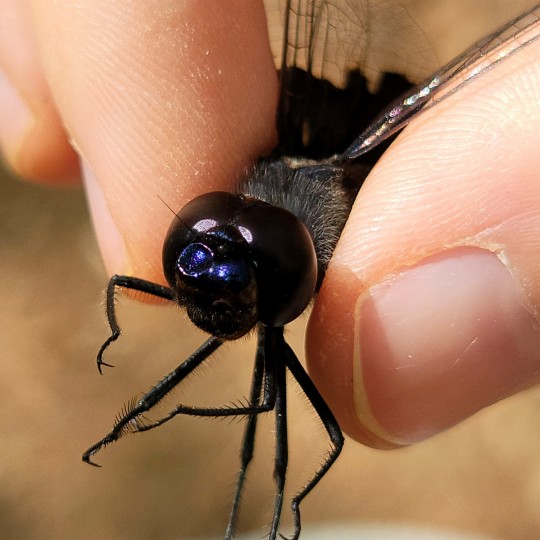
For one, their eyesight is among the best in the insect world. Nearly full 360 degree vision with dense compound eyes that show the world in high detail. The eyes are connected directly to the central nerve cluster allowing for near-instant reaction times and flight adjustment.

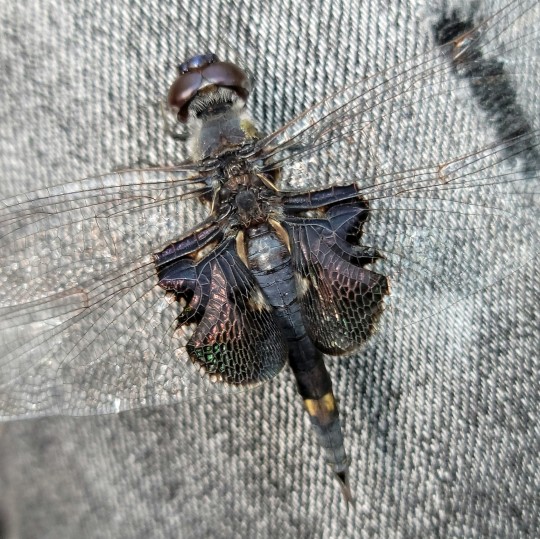
Their broad and aerodynamic wings can each move independently of one another, allowing for complete control over their movements. And more importantly, their signature ability to hover - which actually inspired modern helicopter designs.
While the fastest insect ever recorded was a tiny fly capable of briefly reaching 99mph during takeoff, dragonflies are the fastest insects on average, being able to maintain speeds of over 20mph consistently. The fastest dragonflies can reach 35mph when pursuing prey!
They can maintain these speeds while turning or changing altitude as well. In the wild, it's impressive if a predator has a 40% or higher catch rate of prey. Dragonflies, on the other hand, have a rate around 90%, the highest of any predator on Earth.
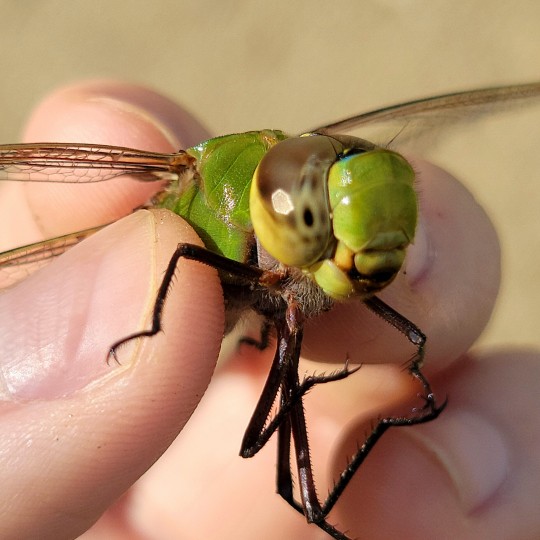
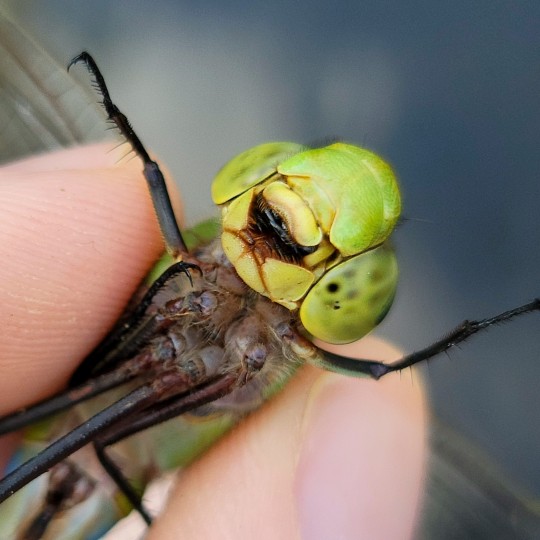
Once prey is caught, their powerful mandibles tear them to shreds mid-air. These pictures here are of a green darner (or an emperor dragonfly, not sure), one of the larger species of dragonfly. Their bite is painful even to humans and can easily draw blood.
Don't worry though - dragonflies have no interest in attacking humans. Their prey is just about anything smaller than them - fish, reptiles, flies, beetles... it doesn't matter, as long as the dragonfly can catch and lift it.
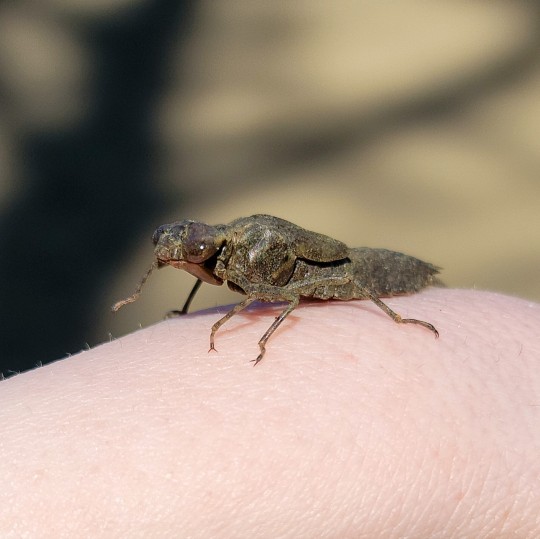
One of the coolest traits about dragonflies, in my opinion however, is their life cycle. Dragonflies start out as "nymphs," which look like freakish alien predators. They live underwater, where they feed on tiny insects - namely mosquito larvae!
That's right - if you've heard that dragonflies help kill mosquitos, it's actually the nymphs doing most of the heavy lifting.

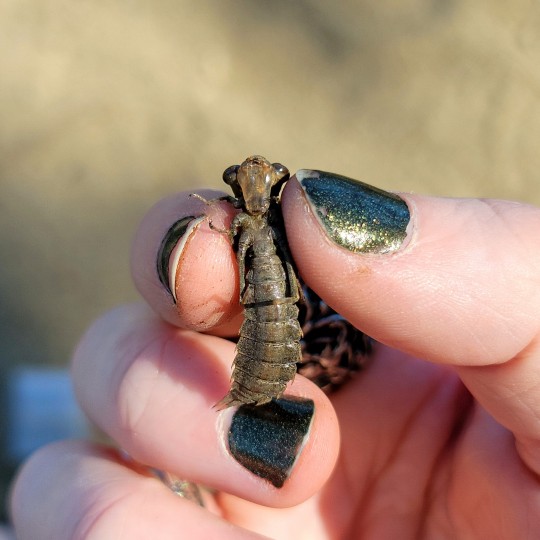
Here's some photos of a dragonfly nymph that was walking across a sandy outcrop on its way to become an adult. When they're ready and grown, they leave the water and find a good spot to shed. This is NOT metamorphosis like what butterflies do (called 'holometaboly'), but instead just it's final shed or molt, or "hemimetaboly."
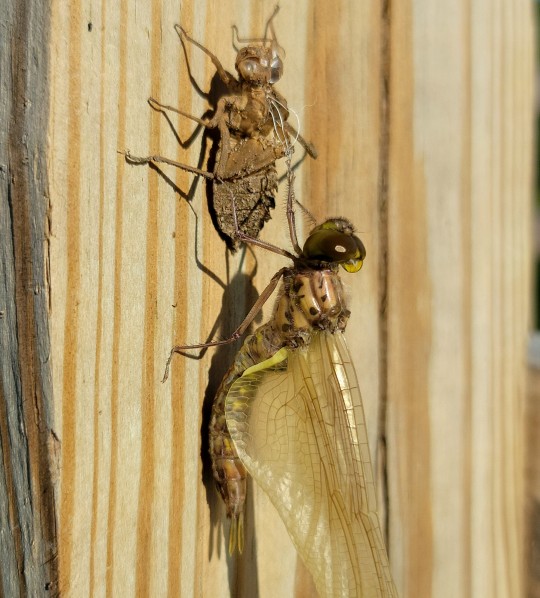
Dragonflies spend the majority of their lives in this state. Only for a brief month or two of their lives are they the flying, hunting adults you see flickering over pond surfaces.
Dragonflies live for about a year, and commonly have 2 or 3 generations per year. During the Winter, the adults all die out, entrusting their survival to the remaining nymphs trapped under the ice.
(all pictures by me)
#bugs#bug#nature#insect#insects#entomology#forest#entymology#invertebrates#photography#dragonfly#dragonflies
19 notes
·
View notes